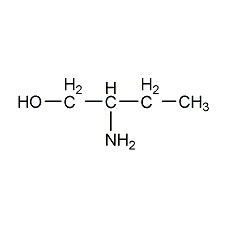
Structural formula
| Business number | 02AP |
|---|---|
| Molecular formula | C4H11NO |
| Molecular weight | 89.14 |
| label |
(±)-2-amino-1-butanol, Butanolamine, (±)-2-Amino-1-butanol, Butanolamine |
Numbering system
CAS number:96-20-8
MDL number:MFCD00008095
EINECS number:202-488-2
RTECS number:EK9625000
BRN number:1098274
PubChem number:24846021
Physical property data
1. Properties: colorless liquid.
2. Density (g/mL, 25/4℃): 0.944
3. Relative vapor density (g/mL, air=1): Undetermined
4. Melting point (ºC): -2
5. Boiling point (ºC, normal pressure): 178
6. Boiling point (ºC, 5.2kPa): Undetermined
7. Refractive index (n20): 1.453
8. Flash point (ºC): 107
9. Specific rotation Degree (º): Undetermined
10. Autoignition point or ignition temperature (ºC): Undetermined
11. Vapor pressure (kPa, 25ºC): Undetermined
12. Saturated vapor pressure (kPa, 60ºC): Undetermined
13. Heat of combustion (KJ/mol): Undetermined
14. Critical temperature (ºC) : Undetermined
15. Critical pressure (KPa): Undetermined
16. Log value of oil-water (octanol/water) partition coefficient: Undetermined
17. Explosion upper limit (%, V/V): Undetermined
18. Explosion lower limit (%, V/V): Undetermined
19. Solubility: Can be compared with Mixable with water, soluble in alcohol and ether. It smells like ammonia.
Toxicological data
1. Acute toxicity: Rat oral LD50: 2300mg/kg; mouse intraperitoneal LDLo: 250mg/kg; mouse intravenous LD50: 316mg/kg;
Ecological data
This substance is slightly hazardous to water.
Molecular structure data
1. Molar refractive index: 25.60
2. Molar volume (cm3/mol): 96.1
3. Isotonic specific volume (90.2K ): 234.4
4. Surface tension (dyne/cm): 35.3
5. Polarizability (10-24cm3): 10.15
Compute chemical data
1. Reference value for hydrophobic parameter calculation (XlogP): -0.4
2. Number of hydrogen bond donors: 2
3. Number of hydrogen bond acceptors: 2
p>
4. Number of rotatable chemical bonds: 2
5. Number of tautomers: none
6. Topological molecule polar surface area 46.2
7. Number of heavy atoms: 6
8. Surface charge: 0
9. Complexity: 30.7
10. Number of isotope atoms: 0
11. Determine the number of atomic stereocenters: 0
12. Uncertain atomic stereocenter Number of stereocenters: 1
13. Determined number of stereocenters of chemical bonds: 0
14. Uncertain number of stereocenters of chemical bonds: 0
15. Total Number of price key units: 1
Properties and stability
1. Avoid contact with strong oxidants and acids.
2. It is harmful and corrosive when taken orally and can cause burns.
Storage method
1. Store in a cool, ventilated warehouse. Keep away from fire and heat sources. Protect from direct sunlight. Keep container tightly sealed. They should be stored separately from oxidants and acids, and avoid mixed storage. Equipped with the appropriate variety and quantity of fire equipment. The storage area should be equipped with emergency release equipment and suitable containment materials.
Synthesis method
1. Obtained from the chlorination addition reaction of butene-1 with acetonitrile and chlorine, followed by hydrolysis, alcoholization and alkalization. With the exception of the alkalizing operation, the process is carried out continuously in the pipelined unit in the following sequence. The purity of Butene-1 is 50-80%. The molar ratio of the chlorination reaction is butene-1: chlorine: acetonitrile = 1: 0.85: 7-8. The reaction temperature is 40-50°C, and the feed flow rate is 2.5-3.0kg/h. After the chlorination reaction is completed, the acetonitrile and dichlorobutane in the reaction are distilled and recovered using an acetonitrile recovery tower. Then carry out alcoholysis reaction, add the distilled reaction liquid to hydrochloric acid and ethanol equivalent to the weight of butene-1, feed at normal pressure, the temperature at the bottom of the tower is 104°C, the temperature at the top of the tower is 72-75°C, and the reaction is carried out while steaming The resulting mixture of ethyl acetate, water and ethanol was produced. The alcoholysis reaction liquid is alkalized with sodium hydroxide and distilled to obtain crude 2-aminobutanol. Finally, products with a content of more than 95% are obtained by fractionation under reduced pressure.
Purpose
1. Used to prepare emulsifiers, surfactants, vulcanization accelerators, organic synthesis, and acid gas absorbers. After separation, (+) 2-aminobutanol is obtained, which is used to produce the anti-tuberculosis drug ethambutol.
2. Organic synthetic acid gas absorbent.
extended-reading:https://www.bdmaee.net/wp-content/uploads/2022/08/Dioctyltin-dichloride-CAS-3542-36-7-Dioctyl-tin-dichloride.pdfextended-reading:https://www.bdmaee.net/catalyst-a400-a400-polyurethane-catalyst-a400/extended-reading:https://www.bdmaee.net/wp-content/uploads/2022/08/Catalyst-8154-NT-CAT8154-polyurethane-catalyst-8154.pdfextended-reading:https://www.bdmaee.net/wp-content/uploads/2020/07/90-1.jpgextended-reading:https://www.newtopchem.com/archives/947extended-reading:https://www.cyclohexylamine.net/cs90-catalyst-dabco-cs90-polyurethane-catalyst-cs90/extended-reading:https://www.newtopchem.com/archives/754extended-reading:https://www.cyclohexylamine.net/category/product/page/18/extended-reading:https://www.bdmaee.net/nt-cat-dmdee-catalyst-cas110-18-9-newtopchem/extended-reading:https://www.bdmaee.net/niax-stannous-octoate-soft-foam-catalyst-momentive/


Comments